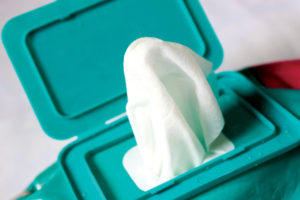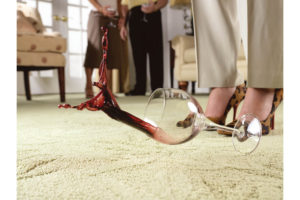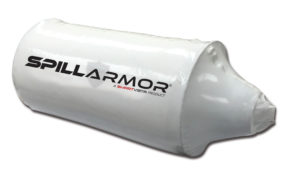Sustainability in textile development and manufacturing is an ongoing conversation, much of it revolving around processes that conserve energy, water and natural resources. Beyond manufacturing processes, however, sustainability issues are driving true technical innovation, resulting in new products that offer a host of advantages.
Replacing PFCs
The search for alternatives to perfluorinated compounds (PFCs) such as PFOA and PFOS, used to render textiles durably water- and stain-repellent in the apparel, carpet and upholstery and outdoor sectors, has been front and center. Loudly condemned by non-governmental organizations and sustainability campaigner Greenpeace, and subsequently by various government organizations, PFCs persist in the environment and bio-accumulate in animals and humans, creating a number of health issues.
The European Union has banned the use of PFOS and is considering a restriction on PFOA. In the U.S., the Environmental Protection Agency negotiated a phase-out of PFOA by 2015 with the chemical companies that produced them.
As a result of the phase-out of PFOAs, textile and chemical companies have been forced to innovate sustainable, water- or bio-based durable water repellent (DWR) finishes such as Chemours™ Teflon Eco-Elite™, Sciessent CURB™, Huntsman PHOBOTEX®, Schoeller® Textil ecorepel®, HeiQ Eco Dry, and Bolger & O’Hearn Altopel F3®.

Based in Fall River, Mass., Bolger & O’Hearn developed Altopel F3 some time ago but felt that testing with the Hohenstein Institute would add legitimacy to the product, which is now being launched via textile marketing group Concept III.
“Sustainability is inspiring us to take a closer look at our raw materials and supply chain,” says Shawn Honeycutt, Bolger & O’Hearn sales manager. “We think we have the best performing product in the market.”
The PFC-free alternatives generally impart a softer hand to textile products and repel water-based stains. However, unlike PFC-based finishes, they do not have the ability to repel oil-based dirt and stains.
As a result, some manufacturers of high-performance outdoor gear, such as Patagonia, Ventura, Calif., and W.L. Gore & Associates, Newark, Del., are funding additional research. Patagonia has invested in a Swiss company called Beyond Surface Technologies that is working to develop better chemistries for outdoor apparel. Gore is putting considerable resources into researching non-PFC materials. The first non-PFC Gore-Tex® products should be available in 2018.
At Chemours, Wilmington, Del., “The story is moving towards stain management. Our customer is asking for it, and we feel we are making strides towards that end,” says Gerald Brown, the company’s principal investigator for textiles R&D.
Improving on nature
While many proponents of sustainable textiles maintain that you can’t beat Mother Nature, the truth is that innovative synthetic materials are being engineered with better green credentials.
Take nonwoven wipes, for example. The market for single use, personal care wipes (which are generally made from polyester) reached $8.2 billion USD in 2013, according to Euromonitor International, and is expected to grow at a compounded annual rate of 3 percent through 2018.
While most wipes are not flushable, ending up in landfills, consumers are demanding the convenience of a flushable wipe. A large proportion of wipes are flushed anyway, much to the dismay of municipalities who must deal with the resulting problem of blocked sewers.
The industry is developing new requirements for flushable wipes; some manufacturers have turned to cellulosic fibers, which can be more easily biodegraded. But cellulosic nonwovens are more expensive and more difficult to process than polyester, according to Bynum Poole, president of the Greenville, S.C.-based Poole Company, a leading distributor of polyester fibers for the nonwovens industry.
Like many polyester suppliers, the company offers post-consumer recycled fibers through their EcoSure® brand. Last year the company took the process a step further with the development of EcoSure® BioBlast™, a biodegradable fiber made from 100 percent recycled polyethylene terephthalate (PET) bottles, shown to biodegrade 12 times faster than traditional polyester fibers in landfill conditions over a year.
While biodegradable is not the same as flushable, it is perhaps a step in the right direction. According to Poole, the product could be tweaked to biodegrade faster to meet the needs of a brand partner. “The nonwovens ship turns around slowly,” he notes. “But we have a lot of interest and ongoing trials.”
EcoSure BioBlast fibers are also seeing interest from outdoor apparel and sock brands as well as the automotive industry, says Poole.
Advanced vegetables

The textile industry is also taking a closer look at the sustainability story being told by bio-based fibers such as DuPont™ Sorona®, which has been around for more than a decade. Given the generic “triexta,” Sorona is a type of polytrimethyl terephthalate (PTT) containing 37 percent Bio-PDO™ (bio-based 1,3 propanediol), made by fermenting glucose from corn.
“We’ve never really told our story,” says John Sagrati, global segment leader for Sorona carpet. “Sorona is more like a natural fiber; it comes from fermentation. Think of us as a natural fiber, with the same softness as cashmere or silk, and great natural springiness. The magic is in designing from nature forward, instead of being ‘just like’ other synthetics in the market.”
Bio-PDO contains three carbons, and nature is filled with three-carbon and six-carbon forms. “People are beginning to understand the concept of ‘biomimicry’,” comments Renee Henze, global marketing manager for Sorona.
Because those carbons are impervious to stains and odor, Sorona has seen its greatest success in carpeting. Sagrati points out that soft, resilient Sorona carpet fibers don’t require coating with silicone softeners or stain-resistant finishes (no PFCs). “It doesn’t look or feel synthetic; there’s no extra stuff on it,” he says. “And moths won’t eat Sorona.”
The Sorona technical team is working closely with carpet mills to develop new blends that take advantage of the fiber’s softness. The team is also working on latex-free backings, further reducing the product’s environmental footprint.
The latest use for sustainable Sorona fiber is in makeup brushes, where it replaces natural animal hair. Sorona’s softness and stain-resistant qualities are also attracting the high-end automobile industry, where “glowing” light-colored interiors are trending, according to Sagrati.
Technology and recycling
The proliferation of “closed loop” textile systems that keep textile waste out of landfills is creating a host of recycled yarns and materials that can be used to make new textiles, primarily for apparel and industrial end uses such as insulation, batting and bedding. In addition, recycled and sustainable materials are being used to engineer highly technical products.

system is made from recycled and
sustainable materials. Photo: SmartVista LLC.
Leaders in this area is Leigh Delaware Holdings, the parent company of South Carolina-based Leigh Fibers, a processor and trader of recycled fibers, and ICE Recycling, which reprocesses polymers, cardboard and metal. Leigh recently announced the formation of a third sister company, SmartVista™, to focus on the development of new products and technologies from these materials for a variety of industries.
SmartVista’s first product, called SpillArmor™ RDS-100, is a lightweight, self-contained emergency response unit designed to rapidly absorb hydrocarbon spills.
“SmartVista will continue developing customer-focused technologies for a wide array of industries where sustainable solutions may not currently be available,” says Mariel McAllister, director of public relations for the three sister companies.
Through sustainable engineering, Leigh Fibers has diverted more than 14 billion pounds of textile waste and by-products from landfills.
There are dozens of sustainability-driven innovations currently in development in the world of textiles, from synthetic spider silk and fibers spun from oceanic plastic waste, to eco-alternatives to spandex, dyes and printing inks, goose down, building materials or geosynthetics. One could argue that sustainable imperatives are perhaps the greatest driver of textile innovation today, giving product developers the opportunity not only to make textiles more sustainable—but to create something new and different in the process.
 TEXTILES.ORG
TEXTILES.ORG



 Since its launch in 2011, the Greenpeace DETOX campaign has pushed for a change in the chemistry behind durable water repellency, and the textile industry has responded. Since 2011, thousands of designers, bloggers, activists and global brands have made a commitment to create toxic-free garments. The textile industry has been a significant player in this effort, developing new PFC-free products for garments and other markets.
Since its launch in 2011, the Greenpeace DETOX campaign has pushed for a change in the chemistry behind durable water repellency, and the textile industry has responded. Since 2011, thousands of designers, bloggers, activists and global brands have made a commitment to create toxic-free garments. The textile industry has been a significant player in this effort, developing new PFC-free products for garments and other markets.